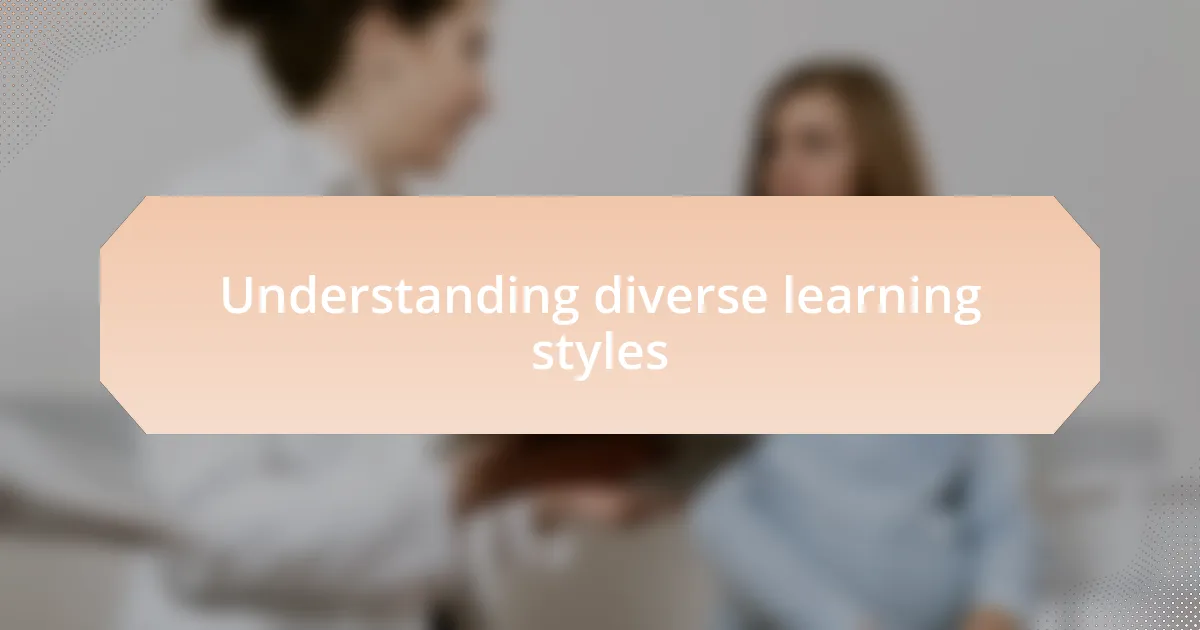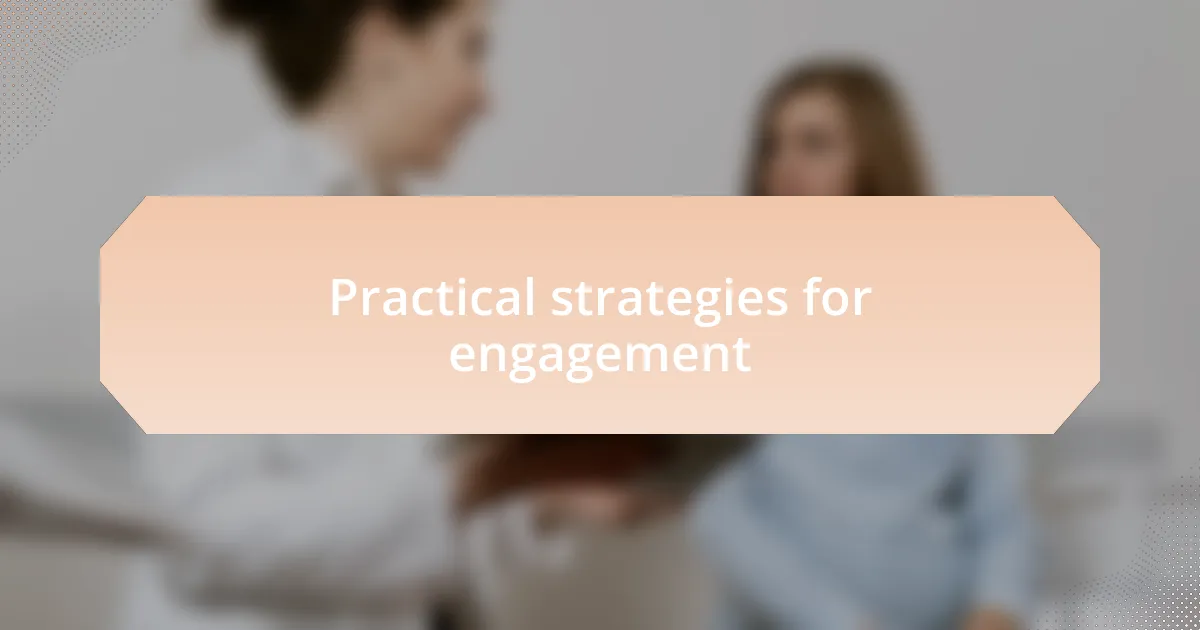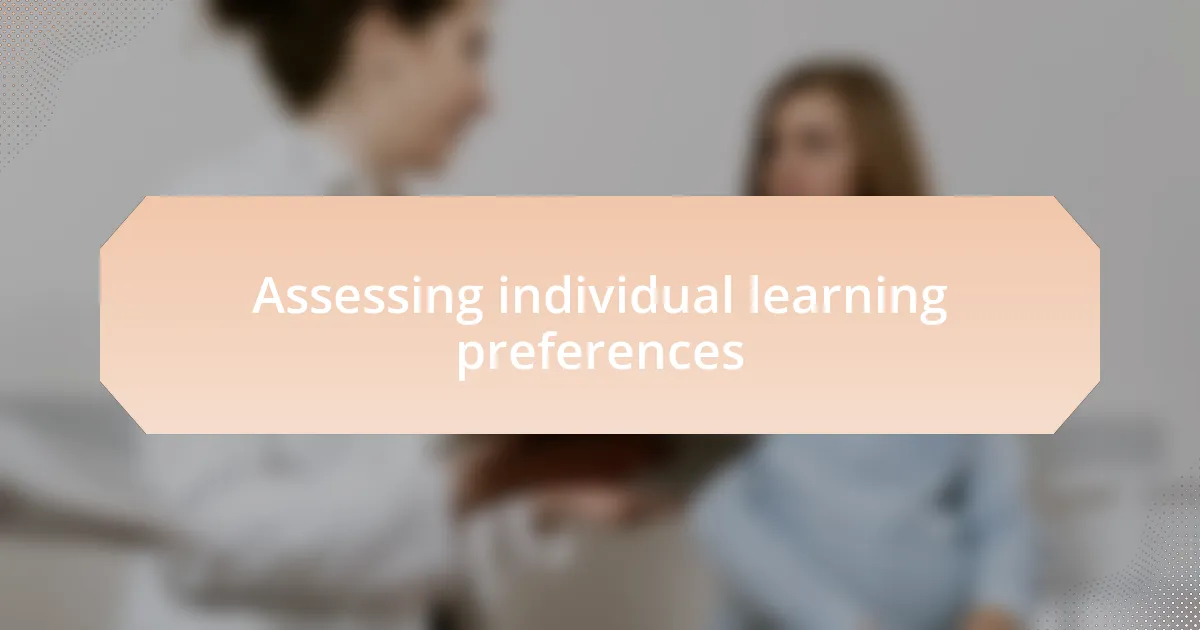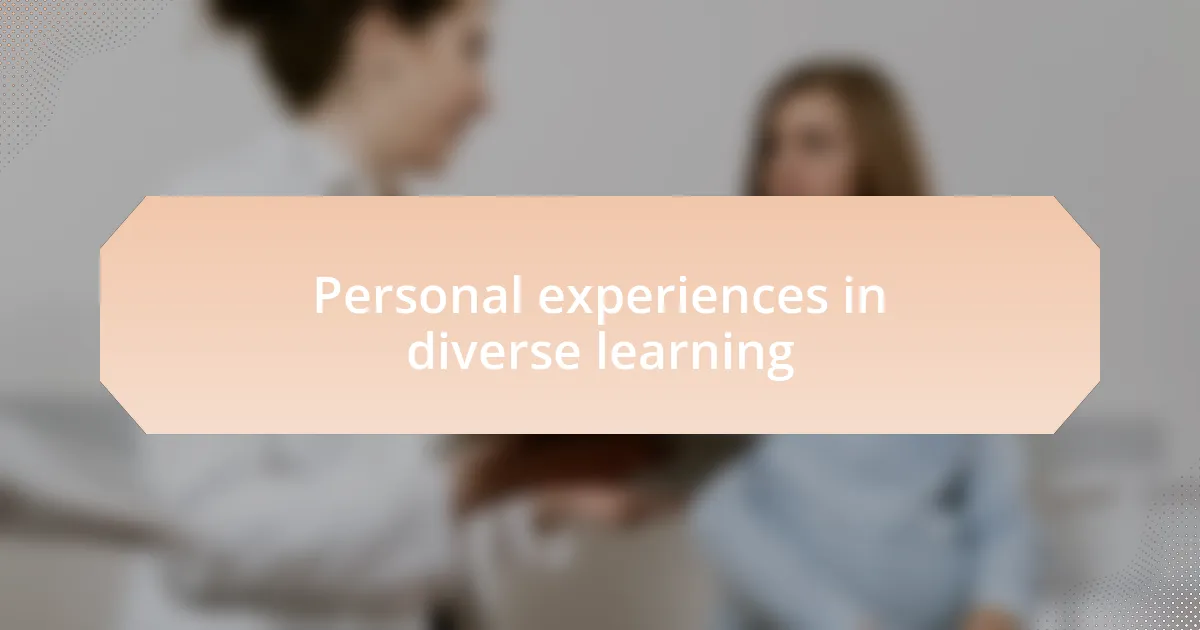Key takeaways:
- Recognizing diverse learning styles in hospital ministry enhances engagement and fosters personal connections.
- Adapting communication strategies, such as incorporating pauses and hands-on activities, can significantly improve understanding and empowerment among participants.
- Utilizing practical strategies, like blending visual aids with storytelling and creating interactive experiences, creates an inclusive and impactful environment.
- Assessing individual learning preferences through observation and dialogue builds trust and ensures that the ministry meets the unique needs of each participant.

Understanding diverse learning styles
Understanding diverse learning styles is essential for creating an inclusive environment, especially in hospital ministry. I often reflect on my own experiences working with individuals who absorb information in various ways. For instance, I remember a patient who was visual in their learning; they needed diagrams and charts to grasp concepts about their health. It was a reminder that one size truly does not fit all.
But how can we truly appreciate these differences? I’ve seen firsthand the transformation that occurs when we acknowledge unique learning preferences. During a group session, integrating storytelling for auditory learners sparked lively discussions, while hands-on activities engaged those who learn by doing. Witnessing the engagement of everyone present highlights the importance of catering to different styles.
As I delve deeper into this variety, I find myself continually inspired by the diverse backgrounds and experiences of each individual. Reflecting on these insights has taught me that understanding diverse learning styles isn’t just about teaching; it’s about connecting with people on a level that resonates with them personally. Have you ever noticed how the same message lands differently depending on how it’s delivered? That realization drives me to adapt my approach, ensuring everyone feels valued and understood.

Adapting communication for different styles
Adapting communication for different styles requires a thoughtful approach. I remember a time in a support group where I noticed a participant struggling to keep up with the conversation. They were more reflective, processing information internally. By incorporating pauses and encouraging them to share their thoughts in a calm manner, the atmosphere shifted. It made me realize that sometimes, silence is as valuable as dialogue.
In another instance, I worked with a young adult ready for discharge. They were a kinesthetic learner, needing to physically engage with their care plan. Using role-playing to demonstrate how to manage their medications turned the information from abstract to tangible. It was gratifying to see their confidence rise as they actively participated, which confirmed for me that hands-on experiences not only facilitate understanding but also empower individuals.
Have you noticed how people often light up when they resonate with what you’re saying? That’s a powerful moment I cherish. Tailoring my communication style not only enhances clarity but also fosters deeper connections. It’s about creating a space where everyone can thrive, which is especially important in the sensitive environment of hospital ministry.

Practical strategies for engagement
Practical strategies for engagement can start with understanding the learning preferences of those in our ministry. I once facilitated a workshop for families dealing with chronic illness, and I noticed that some participants thrived with visual aids while others preferred verbal storytelling. By blending these elements—using visuals alongside sharing personal narratives—we created an environment where everyone felt included and engaged. Isn’t it incredible how a simple adjustment in presentation can spark enthusiasm and participation?
Incorporating activities that cater to different senses can also significantly enhance engagement. During a prayer session, I decided to include an interactive element by inviting participants to write down their hopes and fears on colorful sticky notes. The act of physically placing these notes on a “prayer wall” allowed individuals to express themselves non-verbally, which resonated deeply with the reflective learners. This strategy not only inspired a sense of community but also made the experience more impactful.
Reflection moments are crucial, too. After each session, I invite attendees to share one take-away in a low-pressure environment. This practice helps me gauge which methods resonate most. I can still recall a heartfelt moment when someone shared how a particular lesson shifted their perspective. Isn’t it rewarding to know we’re not just sharing information but also fostering transformation? Each encounter emphasizes that engagement is a dynamic collaboration, and it thrives when nurtured with care and creativity.

Assessing individual learning preferences
Assessing individual learning preferences begins with observation and open dialogue. I remember a time when I initiated one-on-one conversations with ministry participants to understand their backgrounds. Some expressed a preference for hands-on activities, while others identified as auditory learners who thrived on discussions. This insight reminded me that we’re all unique, and taking the time to listen fosters deeper connections.
When I conduct group assessments, I often use simple questionnaires to gauge preferences. It’s fascinating how a few targeted questions can reveal someone’s inclination towards visual, auditory, or kinesthetic learning. One participant once told me that filling out the questionnaire not only helped me tailor my ministry approach but also allowed them to advocate for their own needs. This mutual understanding not only enhances the experience but builds trust within our community.
I also find that informal settings, like coffee chats after service, can be incredibly revealing. During one of these discussions, a member shared how they learned best through storytelling. This prompted me to incorporate more narrative-driven elements into our sessions, further enriching our content. Have you ever noticed how small changes can lead to profound learning experiences? By continually assessing these preferences, I feel empowered to create a nurturing environment that meets everyone’s needs.

Personal experiences in diverse learning
In my own journey, I’ve encountered learners of all stripes, which has shaped how I approach teaching. I’ll never forget a moment when a visually-oriented participant illustrated their understanding with a creative diagram during a class discussion. It was a lightbulb moment for me, showing that when we honor diverse styles, learners feel more engaged and invested in their growth. Have you ever watched someone come alive when they connect with a method that truly resonates with them?
One particular encounter changed my perspective on the power of rhythm in learning. A young participant expressed that chanting scripture helped him memorize passages more effectively. I decided to try integrating musical elements into our sessions, which not only made learning easier for him but also energized the group. It’s incredible how diverse methods can tap into hidden potential, isn’t it? An unexpected benefit was the shared laughter and joy among participants, proving that learning doesn’t have to be tedious.
Reflecting on these interactions, I recognize that fostering an inclusive atmosphere is pivotal. There was a time when I brought together a group with varying learning preferences, and I facilitated a creative workshop. The excitement was palpable as individuals collaborated, each contributing their strengths. Witnessing their growth reaffirmed my belief that we achieve so much more when we embrace diversity in learning styles. How do you think we can further nurture such environments?

Reflection on successful ministry practices
There was a time when I witnessed the impact of storytelling in ministry during a small group session. One of the participants shared a poignant personal testimony that resonated deeply with everyone present. I noticed the room transform; faces softened, and connections deepened as others felt compelled to share their own experiences. It made me realize how powerful personal narratives can be in creating an environment where ministry thrives, as they allow participants to relate on a more profound level. How often do we overlook the importance of sharing our stories in fostering community?
Another effective practice emerged during a recent Bible study focused on interactive discussions. I encouraged everyone to engage in role-playing, allowing them to embody different characters from scripture. Initially skeptical, the group soon found themselves laughing and exploring biblical truths in a way that felt authentic and alive. I was amazed at how this kinesthetic approach sparked deeper understanding and joy in their faith journey. Don’t we often learn best when we move and immerse ourselves in the experience?
Reflecting on these moments, I understand that diversity in learning styles is not merely a consideration – it is essential to ministry success. When I embraced creativity and authenticity in my approach, the atmosphere shifted, fostering deeper connections among participants. I often ponder: what would our ministry look like if we continually prioritized these diverse practices to meet everyone’s unique needs? Our ministry would flourish, inviting even more individuals to engage and grow.